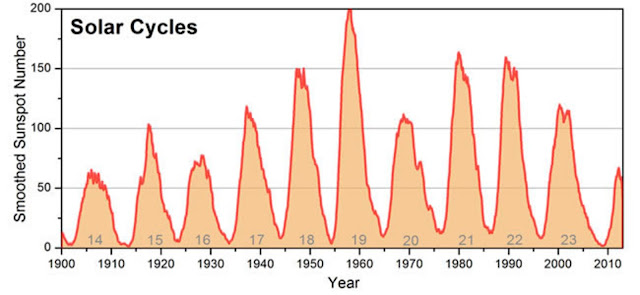Magnetic Field : Sun
Just like a planetary dynamo generates a magnetic field inside the planet, solar dynamo is responsible for the solar magnetic field. The Sun is composed of plasma, i.e, charged particles, which in motion produce magnetic fields. This field is carried away from the sun towards the planets in all directions by the solar wind, and is called the interplanetary magnetic field (IMF). Two interesting phenomena related to the field are its variation and shape.
 |
| Interplanetary magnetic field extending out from the Sun. Credit: Vallée, J 1998 |
The solar magnetic field acts as a bar magnet with two poles. These poles are observed to flip regularly every 11 years. This variation is termed as a solar cycle. The solar minimum, when the field is weak, is considered the start of a solar cycle. The sunspots are lowest during this time. Sunspots are dark spots observed on the surface where the magnetic flux is very high (over 0.2 Teslas).
 |
| Number of sunspots vs time depicting solar cycles. Credit: ESA/NOAA. |
The IMF extending out from the sun with the solar wind travels as a rotating spiral due to the spinning of the sun. This shape is known as the Parker spiral. The sun rotates around every 24 days at the equator and every 35 days at the pole. On average, this is taken to be 27 days and is known as the Carrington rotation.
Image Credit: NASA
The solar magnetic field and its related phenomena are active topics of research. There is still a lot to find and understand!
Shivangi Sharan is a second year PhD student at the Laboratory of Planetology and Geodynamics in France. Her research focusses on the study of the magnetic field of Mars and to infer its internal structure from it. She is an active member of the IAGA Blog Team and can be contacted via e-mail here.

















